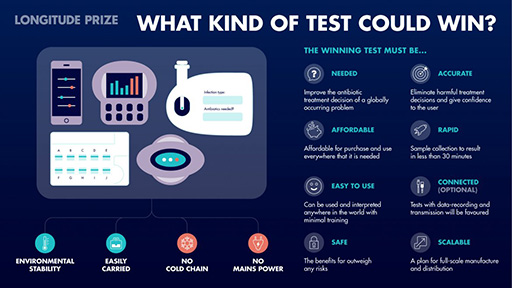4.4 The future for rapid diagnostics
Although rapid diagnostic tests are faster than traditional diagnostic tests at diagnosing an infection, they still often need to be carried out in a laboratory by highly trained staff. Since antibiotics are often given in non-hospital settings, particularly in LMICs, delivering diagnostic information at the
In the next activity you will look at the factors that are important when designing a POC test.
Activity 7 Designing the perfect point-of-care diagnostic test
The Longitude prize is a competition to design a POC diagnostic test. Figure 14 is taken from the Longitude prize website and illustrates some of the factors that need to be considered when designing a POC diagnostic test.
Imagine that you are part of the design team developing a new POC diagnostic test for use in mobile clinics in rural Africa. How would the factors above influence the design of your device?
Discussion
You may have noted down several factors, some that we considered include:
- Mobile clinics in LMICs may not have access to reliable refrigeration or mains power therefore the POC test should be able to be stored at ambient temperature and should operate without the need for external power sources.
- Clinics may not be staffed by highly-trained laboratory technicians so the test should be easy to use and interpret with minimal training.
- Clinics may be in remote locations and patients may have to travel long distances to attend therefore the results should be rapidly obtained so that patients can be diagnosed and prescribed appropriate treatment without needing to return to the clinic.

